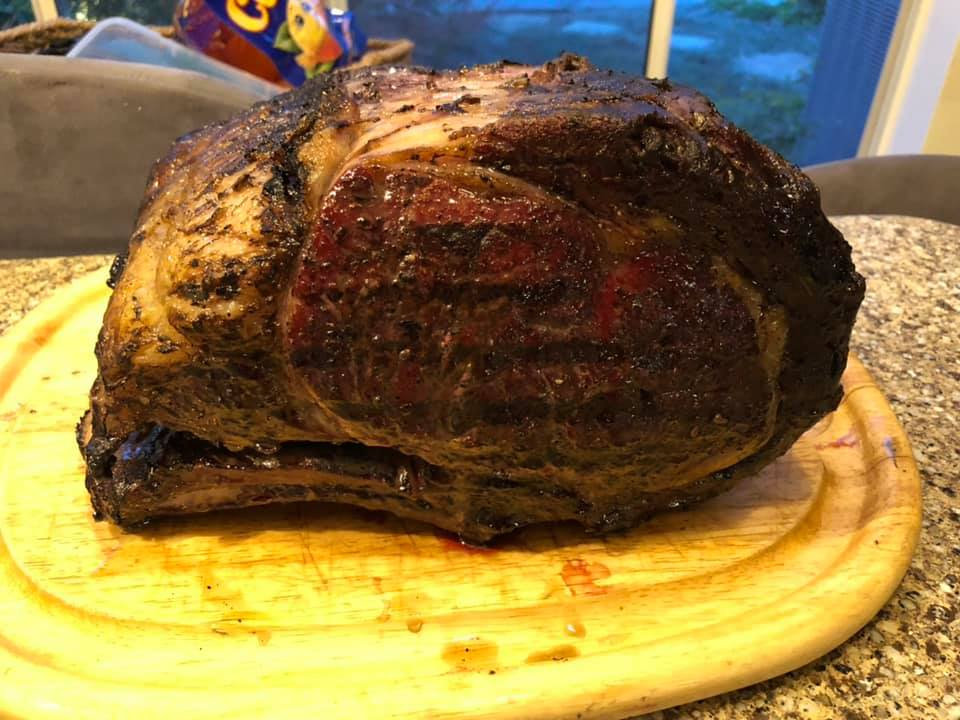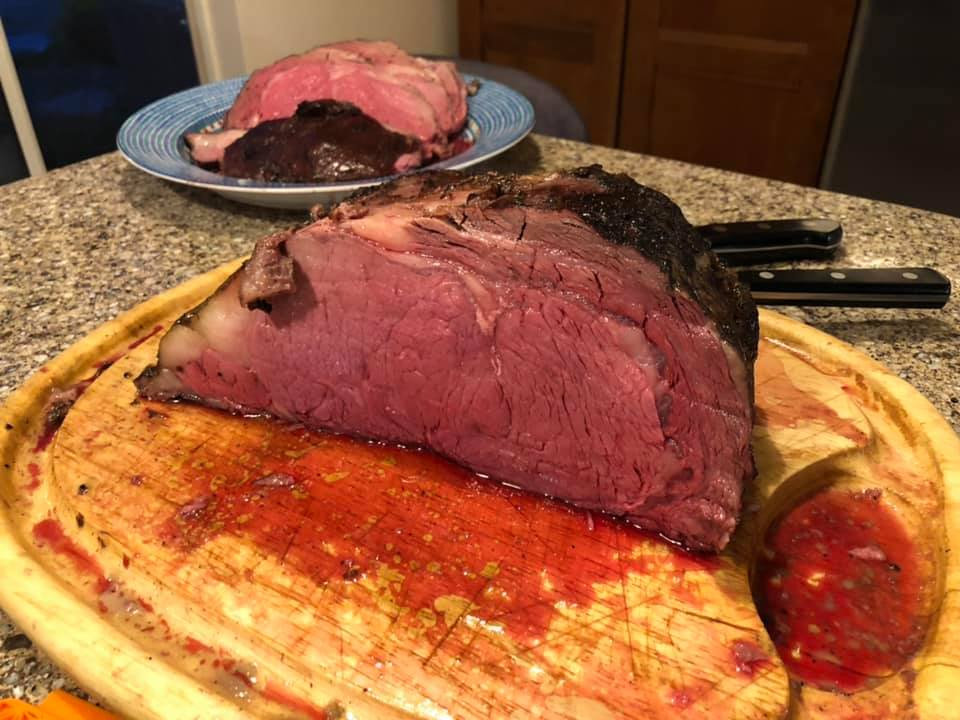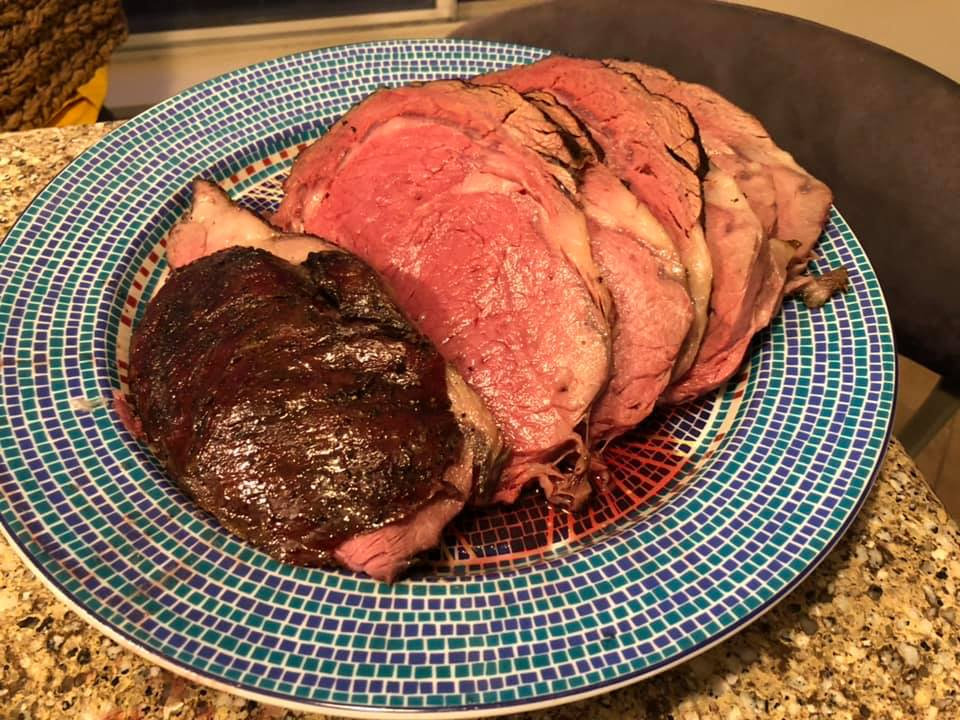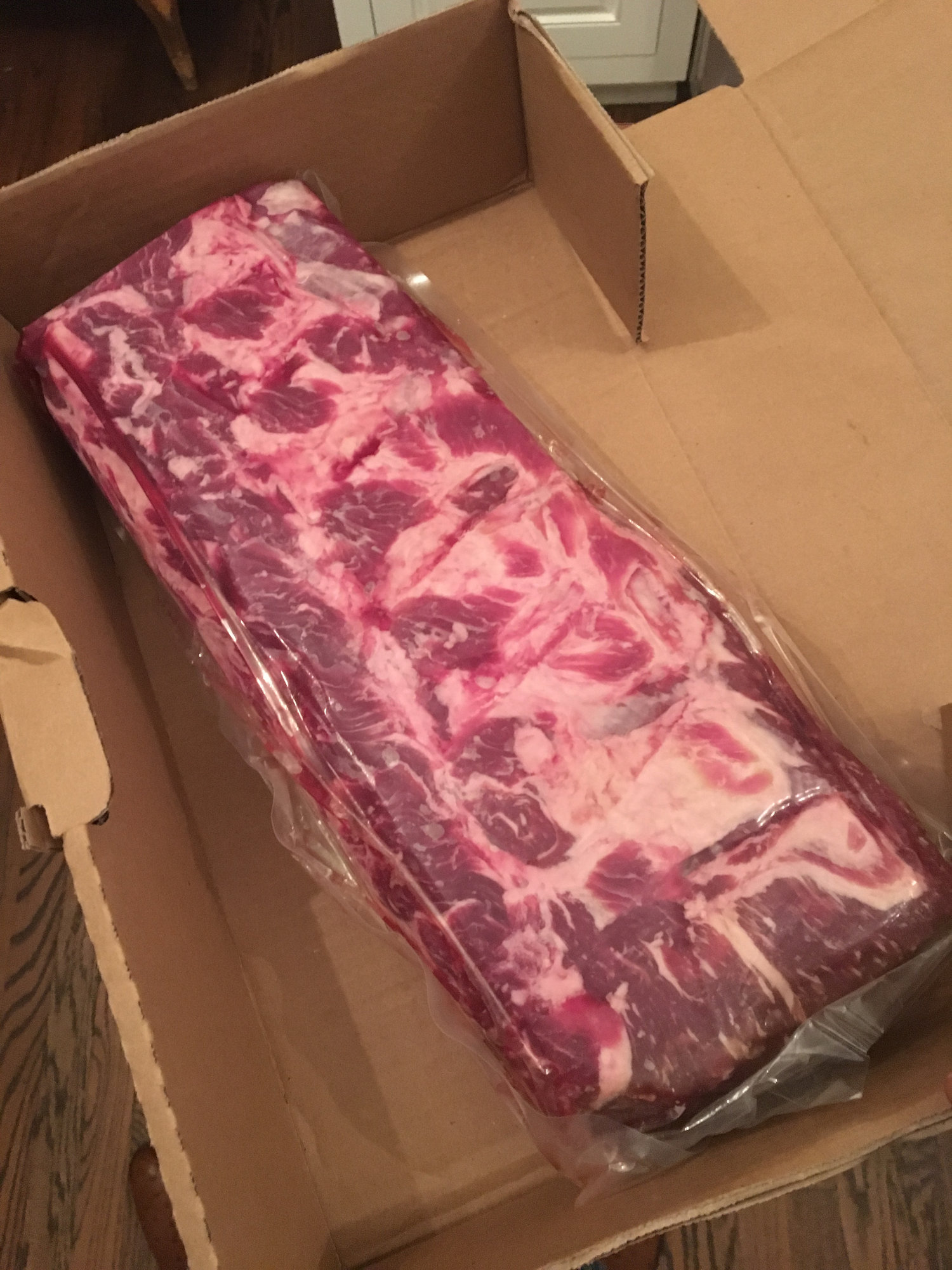Welcome to the EGGhead Forum - a great place to visit and packed with tips and EGGspert advice! You can also join the conversation and get more information and amazing kamado recipes by following Big Green Egg to Experience our World of Flavor™ at:
Want to see how the EGG is made? Click to Watch
Facebook | Twitter | Instagram | Pinterest | Youtube | Vimeo
Share your photos by tagging us and using the hashtag #BigGreenEgg.
Share your photos by tagging us and using the hashtag #BigGreenEgg.
Want to see how the EGG is made? Click to Watch
Christmas Rib Roast Advice

Blassiter
Posts: 195
I would like to get some expert advice on this since there is the added pressure to knock this out of the park for Christmas dinner. I have ordered a 5.5 lb Rib Roast (Prime) from a local butcher shop. In reading a couple other posts, I am second guessing the decision to pay the extra $4\pound for Prime instead of going with Choice. Is Prime better for this or am I just paying the extra money to have more fat that no one is going to eat? Also, I was going to do a reverse sear after cooking at 250. Any idea how long I should expect this to cook? What should my target temp be prior to starting the sear?
Thanks for any advice on this.
Thanks for any advice on this.
LBGE - 2/12/2015
Chesapeake, VA
Comments
-
This is generally what I follow, I usually cook slow in over then sear on the egg.
Tampa, FL -
-
$22? I would keep the order as-is.
Keep unwrapped in the fridge from whenever you get it. Season when you get up and cook at your 225-250 temp. Pull 6-8F below target finish temp. Let rest at least 20 mins. Without looking at the links others will supply, I would guess 90-100 mins ballpark. Loosely tent if you are ahead of schedule and need a longer rest, but only AFTER the temp stops rising. Reverse sear if you need to, but I never do. Have long tongs ready for the fireball you will have with a PR reverse sear.
--------------------------------------------------
Burning lump in Downingtown, PA or diesel in Cape May, NJ.
....just look for the smoke!
Large and MiniMax
--------------------------------------------------Caliking said: Meat in bung is my favorite. -
It will be delicious, nothing wrong with going prime IMO. “Prime rib” is thrown around a lot when many cuts are choice or below. The fact that you’ll be serving legit prime rib is not a bad thing, enjoy it!
BTW, I am going to be doing my first rib roast for Christmas Eve so I’m watching this thread now as well. -
The prime part is a personal taste. I find it fatty but others find it perfect. I remove or have removed the rib rack. I then use my seasoning over the whole roast and then tie the rib rack back on. After the long smoke I then remove the rack again for the final sear. I purchased grill grates after doing my first couple because the flare up is near unmanageable. Good luck. That rib rack will make the very best beef broth you’ve ever had.
-
Beef broth? Can you expand on this?GrillSgt said:That rib rack will make the very best beef broth you’ve ever had.LBGE - 2/12/2015
Chesapeake, VA
-
I think he is referencing AuJus. Run a search, I believe @RRP has a solution well documented and proven....or it may be time for him to repost for everyone's benefit.Blassiter said:
Beef broth? Can you expand on this?GrillSgt said:That rib rack will make the very best beef broth you’ve ever had.
Ellijay GA with a Medium & MiniMax
Well, I married me a wife, she's been trouble all my life,
Run me out in the cold rain and snow -
No actually I was talking about broth. I make a blue cheese sauce and a horseradish sauce to accompany the prime rib.
For the broth I simmer the bones with meat with mirepoix (2-3 med onions, 2 large stalks of celery, 2 large carrots, head of garlic (just cut it in half), bay leaf, and peppercorns for a couple of hours. I recommend using a good commercial beef broth instead of water as it adds a remarkable amount of depth. I then strain the liquid and put the bones in the oven at 375ish to roast until they are a nice dark brown (45 mins or so). Then back to the broth for a couple more hours of gentle simmer. The second simmer is when I add the salt to taste. I find it important to never boil and not to go past the gentle simmer for texture, boiling leaves it gelatinous. -
My bad.GrillSgt said:No actually I was talking about broth. I make a blue cheese sauce and a horseradish sauce to accompany the prime rib.
For the broth I simmer the bones with meat with mirepoix (2-3 med onions, 2 large stalks of celery, 2 large carrots, head of garlic (just cut it in half), bay leaf, and peppercorns for a couple of hours. I recommend using a good commercial beef broth instead of water as it adds a remarkable amount of depth. I then strain the liquid and put the bones in the oven at 375ish to roast until they are a nice dark brown (45 mins or so). Then back to the broth for a couple more hours of gentle simmer. The second simmer is when I add the salt to taste. I find it important to never boil and not to go past the gentle simmer for texture, boiling leaves it gelatinous. Ellijay GA with a Medium & MiniMax
Ellijay GA with a Medium & MiniMax
Well, I married me a wife, she's been trouble all my life,
Run me out in the cold rain and snow -
-
I think I'm going to do prime rib this year. First time ever.
2 LBGE, Blackstone 36, Jumbo Joe
Egging in Southern Illinois (Marion)
-
Mom always did it just the opposite. Nuclear hot to start, Coast low and slow to the finish. It was always awesome.Dyal_SC said:Great advice here from @NibbleMeThis
http://www.nibblemethis.com/2011/12/reverse-seared-prime-rib-roast.html?m=1
When I do mine on the Egg, I roast indirect at 350* or so until 120* internal, then shut the Egg down for 30 minutes more. Then it comes off and rests another 30 minutes prior to carving. Always a perfect medium rare with an amazing crust. I apply a prime rib rub in advance and let the roast sit in the fridge at least three or four days. This year I’m going two weeks to dry age it a bit.Michiana, South of the border. -
It cooks much faster than Time and temp guides in my experience fwiw
-
Thanks for all the great advice. I will be sure to post pictures of the final product. Merry Christmas!
LBGE - 2/12/2015
Chesapeake, VA
-
@Teefus, I'm surprised that doesn't overcook it a fair amount. When I just pull one off at 120 it rises to 125-127. And the egg doesn't really cool down when you shut it down - so that's like 30 more minutes at 300+ degrees. Have you ever measured the temp after you pull it off?Teefus said:
Mom always did it just the opposite. Nuclear hot to start, Coast low and slow to the finish. It was always awesome.Dyal_SC said:Great advice here from @NibbleMeThis
http://www.nibblemethis.com/2011/12/reverse-seared-prime-rib-roast.html?m=1
When I do mine on the Egg, I roast indirect at 350* or so until 120* internal, then shut the Egg down for 30 minutes more. Then it comes off and rests another 30 minutes prior to carving. Always a perfect medium rare with an amazing crust. I apply a prime rib rub in advance and let the roast sit in the fridge at least three or four days. This year I’m going two weeks to dry age it a bit.XXL BGE, Karebecue, Klose BYC, Chargiller Akorn Kamado, Weber Smokey Mountain, Grand Turbo gasser, Weber Smoky Joe, and the wheelbarrow that my grandfather used to cook steaks from his cattle
San Antonio, TX
-
Long before I bought my LBGE, I would do the same in my oven. It's called the "no peek" roast. I'd have the oven to 450*, put the roast in there for "X" many minutes, depending upon how large the roast was, then shut the oven off. I'd have a probe in it and when it read 120* I'd take it out and let it sit for a few more minutes.Foghorn said:
@Teefus, I'm surprised that doesn't overcook it a fair amount. When I just pull one off at 120 it rises to 125-127. And the egg doesn't really cool down when you shut it down - so that's like 30 more minutes at 300+ degrees. Have you ever measured the temp after you pull it off?Teefus said:
Mom always did it just the opposite. Nuclear hot to start, Coast low and slow to the finish. It was always awesome.Dyal_SC said:Great advice here from @NibbleMeThis
http://www.nibblemethis.com/2011/12/reverse-seared-prime-rib-roast.html?m=1
When I do mine on the Egg, I roast indirect at 350* or so until 120* internal, then shut the Egg down for 30 minutes more. Then it comes off and rests another 30 minutes prior to carving. Always a perfect medium rare with an amazing crust. I apply a prime rib rub in advance and let the roast sit in the fridge at least three or four days. This year I’m going two weeks to dry age it a bit.
Now that I have my Egg, I prefer the reverse sear because the meat is more uniform in its done-ness.
I've never tried what @Teefus has done, but I wouldn't be surprised if it works just fine.Large BGE
Neenah, WI -
This can be the easiest cook on the BGE.For me, the easiest and most consistent results with a roast are to go low, about 225-250 or so, and let it cook gently until it hits your desired internal temperature. There will be minimal carryover (you do not foil a resting roast, just let it stand on the ribs on the cutting board).All of which means: no sear at the start or end. You'll have a better and browner mahogany brown crust, with no blackening and, if you have an herb crust or rub on it, you won't mess that up manhandling the roast around with tongs or rolling it in the grate during a "sear".I'd ask what the sear is meant to achieve. If it is a crust, well, it's not necessary to sear for that. And it can actually damage a crust (rub etc.).If it is for show, that's fine too. Guys outside, spiking the BGE to temp, and playing with fire. All good.But after doing these off and on for many years, I have settled into putting the meat on in advance of the crowd arriving. We futz around in the kitchen, and hang out with guests when they arrive, and the roast just cruises, no tending.Take it off when it is about 5-10 degrees shy. I don't usually get much carryover at the lower roasting temperature. Let stand while everything else is coming together, and then eat.Trying a sear once, I found a lot of flare up (rib eye is fatty), blackening, and not much added to the crust. In fact it disturbed the crust, and gave it grid marks. It can even soften the crust, if the fat starts to moisten up due to water being forced out under the higher heat. Worst was early on, one of my first rib eye cooks, where the added heat at the end drove carryover way past med rare.Big fan of keeping it simple. It'll still be memorable no matter what you do. I just vote for simple.Biggest tip: Let it dry a couple days at least uncovered in the refrigerator. That helps the crust too. Dry fat is what browns, and a fresh (not air-dried) roast won't brown until the surface dries off anyway (in the egg). Give it a head start
-
"I've made a note never to piss you two off." - Stike
"The truth is, these are not very bright guys, and things got out of hand." - Deep Throat -
st¡ke said:This can be the easiest cook on the BGE.For me, the easiest and most consistent results with a roast are to go low, about 225-250 or so, and let it cook gently until it hits your desired internal temperature. There will be minimal carryover (you do not foil a resting roast, just let it stand on the ribs on the cutting board).All of which means: no sear at the start or end. You'll have a better and browner mahogany brown crust, with no blackening and, if you have an herb crust or rub on it, you won't mess that up manhandling the roast around with tongs or rolling it in the grate during a "sear".I'd ask what the sear is meant to achieve. If it is a crust, well, it's not necessary to sear for that. And it can actually damage a crust (rub etc.).If it is for show, that's fine too. Guys outside, spiking the BGE to temp, and playing with fire. All good.But after doing these off and on for many years, I have settled into putting the meat on in advance of the crowd arriving. We futz around in the kitchen, and hang out with guests when they arrive, and the roast just cruises, no tending.Take it off when it is about 5-10 degrees shy. I don't usually get much carryover at the lower roasting temperature. Let stand while everything else is coming together, and then eat.Trying a sear once, I found a lot of flare up (rib eye is fatty), blackening, and not much added to the crust. In fact it disturbed the crust, and gave it grid marks. It can even soften the crust, if the fat starts to moisten up due to water being forced out under the higher heat. Worst was early on, one of my first rib eye cooks, where the added heat at the end drove carryover way past med rare.Big fan of keeping it simple. It'll still be memorable no matter what you do. I just vote for simple.Biggest tip: Let it dry a couple days at least uncovered in the refrigerator. That helps the crust too. Dry fat is what browns, and a fresh (not air-dried) roast won't brown until the surface dries off anyway (in the egg). Give it a head starthow do you keep the helpful people from putting foil on it
 every single friggin timefukahwee maineyou can lead a fish to water but you can not make him drink it
every single friggin timefukahwee maineyou can lead a fish to water but you can not make him drink it -
Use grill grates for flare up issues and they are big issues with this.
-
This.st¡ke said:This can be the easiest cook on the BGE.For me, the easiest and most consistent results with a roast are to go low, about 225-250 or so, and let it cook gently until it hits your desired internal temperature. There will be minimal carryover (you do not foil a resting roast, just let it stand on the ribs on the cutting board).All of which means: no sear at the start or end. You'll have a better and browner mahogany brown crust, with no blackening and, if you have an herb crust or rub on it, you won't mess that up manhandling the roast around with tongs or rolling it in the grate during a "sear".I'd ask what the sear is meant to achieve. If it is a crust, well, it's not necessary to sear for that. And it can actually damage a crust (rub etc.).If it is for show, that's fine too. Guys outside, spiking the BGE to temp, and playing with fire. All good.But after doing these off and on for many years, I have settled into putting the meat on in advance of the crowd arriving. We futz around in the kitchen, and hang out with guests when they arrive, and the roast just cruises, no tending.Take it off when it is about 5-10 degrees shy. I don't usually get much carryover at the lower roasting temperature. Let stand while everything else is coming together, and then eat.Trying a sear once, I found a lot of flare up (rib eye is fatty), blackening, and not much added to the crust. In fact it disturbed the crust, and gave it grid marks. It can even soften the crust, if the fat starts to moisten up due to water being forced out under the higher heat. Worst was early on, one of my first rib eye cooks, where the added heat at the end drove carryover way past med rare.Big fan of keeping it simple. It'll still be memorable no matter what you do. I just vote for simple.Biggest tip: Let it dry a couple days at least uncovered in the refrigerator. That helps the crust too. Dry fat is what browns, and a fresh (not air-dried) roast won't brown until the surface dries off anyway (in the egg). Give it a head start
Every bit of it.
I cook for a pretty discerning crowd at Christmas. Some in the hotel/restaurant industry. One grew up working in a butcher shop and is an egghead. One is a foodie who makes some of the best sausage and beer I've ever tasted. They all agreed that the prime rib I cook this way is superior to any prime rib I've ever seared - reverse or otherwise.XXL BGE, Karebecue, Klose BYC, Chargiller Akorn Kamado, Weber Smokey Mountain, Grand Turbo gasser, Weber Smoky Joe, and the wheelbarrow that my grandfather used to cook steaks from his cattle
San Antonio, TX
-
Hmmm. This has me questioning my approach for next week. Maybe I'll get another roast and do comparison cooks?Foghorn said:
This.st¡ke said:This can be the easiest cook on the BGE.For me, the easiest and most consistent results with a roast are to go low, about 225-250 or so, and let it cook gently until it hits your desired internal temperature. There will be minimal carryover (you do not foil a resting roast, just let it stand on the ribs on the cutting board).All of which means: no sear at the start or end. You'll have a better and browner mahogany brown crust, with no blackening and, if you have an herb crust or rub on it, you won't mess that up manhandling the roast around with tongs or rolling it in the grate during a "sear".I'd ask what the sear is meant to achieve. If it is a crust, well, it's not necessary to sear for that. And it can actually damage a crust (rub etc.).If it is for show, that's fine too. Guys outside, spiking the BGE to temp, and playing with fire. All good.But after doing these off and on for many years, I have settled into putting the meat on in advance of the crowd arriving. We futz around in the kitchen, and hang out with guests when they arrive, and the roast just cruises, no tending.Take it off when it is about 5-10 degrees shy. I don't usually get much carryover at the lower roasting temperature. Let stand while everything else is coming together, and then eat.Trying a sear once, I found a lot of flare up (rib eye is fatty), blackening, and not much added to the crust. In fact it disturbed the crust, and gave it grid marks. It can even soften the crust, if the fat starts to moisten up due to water being forced out under the higher heat. Worst was early on, one of my first rib eye cooks, where the added heat at the end drove carryover way past med rare.Big fan of keeping it simple. It'll still be memorable no matter what you do. I just vote for simple.Biggest tip: Let it dry a couple days at least uncovered in the refrigerator. That helps the crust too. Dry fat is what browns, and a fresh (not air-dried) roast won't brown until the surface dries off anyway (in the egg). Give it a head start
Every bit of it.
I cook for a pretty discerning crowd at Christmas. Some in the hotel/restaurant industry. One grew up working in a butcher shop and is an egghead. One is a foodie who makes some of the best sausage and beer I've ever tasted. They all agreed that the prime rib I cook this way is superior to any prime rib I've ever seared - reverse or otherwise.Michiana, South of the border. -
@Teefus - nothing wrong with great beef practice cooks...unless you get into beef protein food coma before the main event.Louisville; Rolling smoke in the neighbourhood. Life is too short for light/lite beer! Seems I'm livin in a transitional period. CHEETO (aka Agent Orange) makes Nixon look like a saint.
-
I just did a 10.5 pound roast this past weekend. Started at 225-250 for about 4 hours, pulled off at 125 to rest and then a quick sear for some bark.




-
I started a thread with a question on the same cut of beef but doing it sous Vide versus low and slow. How long does a 7-10# roast take to get to 130-135? Gonna have more eaters towards the medium versus medium rare. 4 hours or so on the BGe is better than the 8 hours in the water bath in my opinion, especially on Xmas day
-
Great looking cook MikeDV.
-
I am cooking my first Boneless Prime Rib on XMAS Day. Plan on using the reverse sear method as well.
-
Got mine today......10.25#, gonna trim about 1/3 off into individual steaks for later.

-
Any seasoning advice? Saw one post with olive oil, fresh garlic and parsley. Could also do kosher salt, fresh black pepper and a little bit of garlic powder.
-
Can anyone ballpark how long it would take to reach 120-130 internal temp at around 250 indirect? Based on the post by @MikeDV, it's looking like around 20 min per pound. Thanks!
Richardlarge BGE, Birmingham, AL
Categories
- All Categories
- 184K EggHead Forum
- 16.1K Forum List
- 461 EGGtoberfest
- 1.9K Forum Feedback
- 10.5K Off Topic
- 2.4K EGG Table Forum
- 1 Rules & Disclaimer
- 9.2K Cookbook
- 15 Valentines Day
- 118 Holiday Recipes
- 348 Appetizers
- 521 Baking
- 2.5K Beef
- 90 Desserts
- 167 Lamb
- 2.4K Pork
- 1.5K Poultry
- 33 Salads and Dressings
- 322 Sauces, Rubs, Marinades
- 548 Seafood
- 175 Sides
- 122 Soups, Stews, Chilis
- 40 Vegetarian
- 103 Vegetables
- 315 Health
- 293 Weight Loss Forum

















